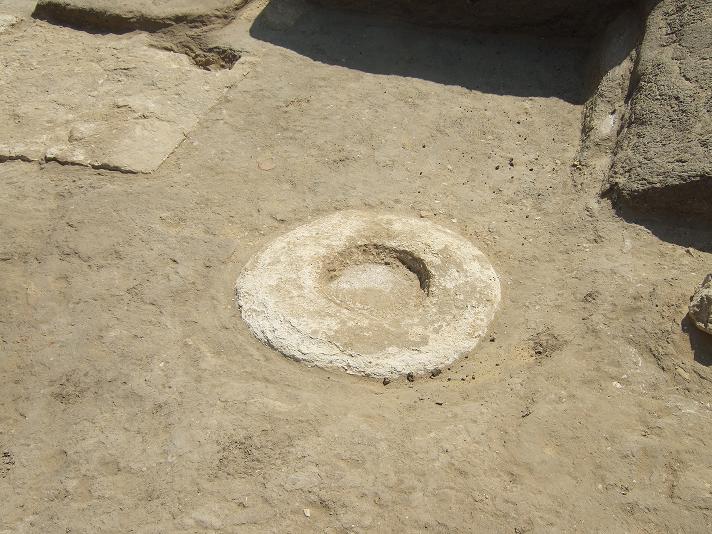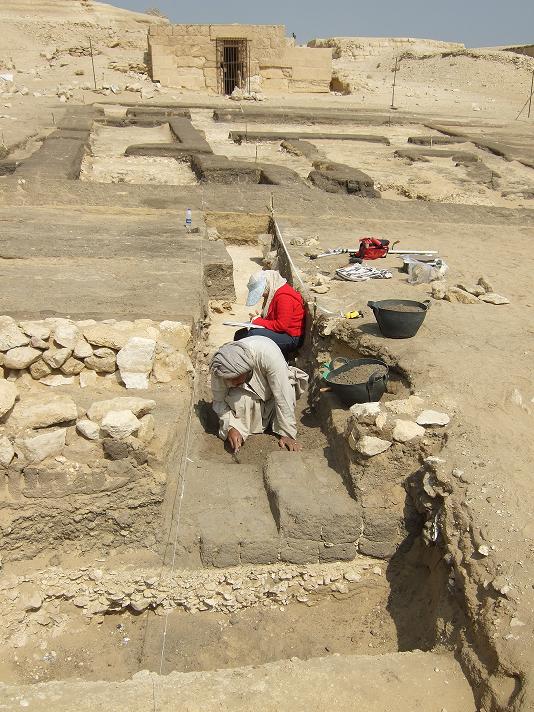A small group of us had dinner with Mark Lehner last night and I caught up with him at the dig site this morning. One of the fascinating stories he told today was about the apparent pattern of occupation, abandonment, and then reoccupation of the Menkaure valley temple (MVT) and perhaps the Khentkawes town (KKT) as well.

Column base at entrance to MVT; recorded by Reisner, re-excavated by AERA.
AERA is re-excavating areas that Reisner and Hassan both recorded. In general, those researchers, however, did not do an in depth study of the phasing of the two sites, which was not common in their era (although Reisner did two phases in MVT). Phasing refers to an examination of the relationships between stratigraphy or layers of archaeology to determine when structures were built relative to each other. This is one of AERA’s key goals at MVT and KKT.
Reisner recorded evidence of perhaps 350 years of occupation in the town that eventually overtook the Menkaure temple. When the temple town was abandoned, layers of aeolian (windblown) sand accumulated. Those layers were subsequently built upon when the site was reoccupied. The last king of the 6th Dynasty, Pepi II, left a record that he restored the temple during his reign, hundreds of years after Menkaure’s son had inaugurated his father’s cult.
Mark thinks it’s more common than not that these kinds of settlements came to overtake the temples around which they were originally founded. This happened also at Medinet Habu, the New Kingdom mortuary temple of Ramses III in Thebes, thousands of years after Menkaure’s temple and town were finally abandoned.
Because the Khentkawes town abuts the Menkaure precinct, AERA archaeologists, Mike House and Kate Liszka, are trying to determine the relationship between the phases of building where the sites adjoin.

Mike House is examining the relationships of abutting features between MVT and KKT.
This is a reference to Khentkawes I at Giza, as opposed to Khentkawes II at Abusir (they may be the same person). Khentkawes chose to erect an enormous private monument, causeway, and sacred town near her father (presumably Menkaure) at Giza.

Grand monument of Queen Khentkawes, with Khafre’s pyramid in background.
On Khentkawes’ monument, there is an inscription that could be read as either “Mother of two kings of Upper and Lower Egypt” or “Mother the king of Upper and Lower Egypt AND King of Upper and Lower Egypt.”

Enigmatic Khentkawes inscription.
Did she take the reins of power? We know very little about her other than what she left at Giza.
One of the sections of her complex being restudied is the causeway that extended from Khentkawes’ burial monument through her adjoining town to the east. Hanan Mahmoud is comparing Hassan’s maps from 1932 to her re-excavation of the causeway. She has found evidence here, as at MVT, of periods of abandonment, reoccupation, and repair to the causeway.

Re-excavating the KKT causeway.
Hanan is an inspector with the Giza taftish, the office that administers the Giza Plateau. She’s a glowing example of the success of the AERA/ARCE field school, having become a fine archaeologist in her own right and a valued member of the team. AERA is proud to see the field school alumni making new contributions to their country’s heritage, and happy to see them enjoying this fulfilling work.

Hanan Mahmoud: AERA/ARCE Field School grad and SCA inspector.
Brian Hunt
